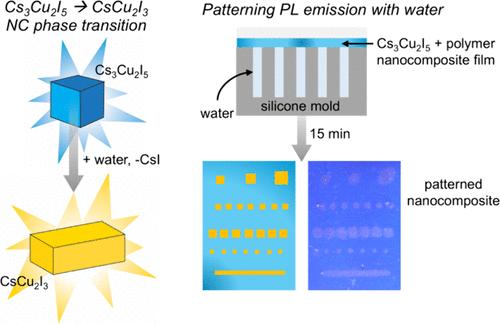功能聚合物配体对碘化铜铯纳米晶体相变和光致发光的调控
IF 7
2区 材料科学
Q2 CHEMISTRY, PHYSICAL
引用次数: 0
摘要
铯铜卤化纳米晶体(NCs),如那些具有Cs3Cu2I5化学计量的纳米晶体,是高量子产率的宽带发射体,具有诱人的应用前景,如在发光显示器和x射线闪烁结构中作为无铅钙钛矿纳米晶体。再加上由于不含铅而具有良好的可持续性,这些纳米材料在暴露于水或醇时,其光致发光从蓝色(Cs3Cu2I5相)独特地转变为黄色(CsCu2I3相),产生由发出白光的混合相组成的纳米材料。在这里,我们描述了含配体聚合物的Cs3Cu2I5纳米复合材料,这些聚合物对相变提供了明显的控制。聚合物配体中官能团的选择──例如;羧酸、叔胺和n -氧化物──独特地改变了NC相变,从阻止这种转变到促进这种转变,在某些情况下,使相之间的可逆性成为可能。这些发现导致了配体功能化聚合物与硅基印花相结合的实现,以产生不同形状和发射波长的图案薄膜。本文章由计算机程序翻译,如有差异,请以英文原文为准。

Functional Polymer Ligands Modulate Phase Transitions and Photoluminescence of Cesium Copper Iodide Nanocrystals
Cesium copper(I) halide nanocrystals (NCs), such as those with Cs3Cu2I5 stoichiometry, are high quantum yield broadband emitters that are enticing prospects for applications as lead-free perovskite NCs, such as in light-emitting displays and X-ray scintillation constructs. Combined with their favorable sustainability owing to the absence of lead, the photoluminescence emission of these NCs uniquely transitions from blue (the Cs3Cu2I5 phase) to yellow (the CsCu2I3 phase) upon exposure to water or alcohols, yielding NCs composed of mixed phases that emit white light. Here, we describe nanocomposites of Cs3Cu2I5 NCs with ligand-bearing polymers that provide distinct control over the phase transitions. The selection of functional groups in the polymer ligands─e.g., carboxylates, tertiary amines, and N-oxides─uniquely altered NC phase transitions, ranging from preventing such transitions to facilitating them and, in some cases, enabling reversibility between phases. These findings led to the implementation of ligand-functionalized polymers in combination with silicone stamps to produce patterned films of different shapes and emission wavelengths.
求助全文
通过发布文献求助,成功后即可免费获取论文全文。
去求助
来源期刊

Chemistry of Materials
工程技术-材料科学:综合
CiteScore
14.10
自引率
5.80%
发文量
929
审稿时长
1.5 months
期刊介绍:
The journal Chemistry of Materials focuses on publishing original research at the intersection of materials science and chemistry. The studies published in the journal involve chemistry as a prominent component and explore topics such as the design, synthesis, characterization, processing, understanding, and application of functional or potentially functional materials. The journal covers various areas of interest, including inorganic and organic solid-state chemistry, nanomaterials, biomaterials, thin films and polymers, and composite/hybrid materials. The journal particularly seeks papers that highlight the creation or development of innovative materials with novel optical, electrical, magnetic, catalytic, or mechanical properties. It is essential that manuscripts on these topics have a primary focus on the chemistry of materials and represent a significant advancement compared to prior research. Before external reviews are sought, submitted manuscripts undergo a review process by a minimum of two editors to ensure their appropriateness for the journal and the presence of sufficient evidence of a significant advance that will be of broad interest to the materials chemistry community.
 求助内容:
求助内容: 应助结果提醒方式:
应助结果提醒方式:


